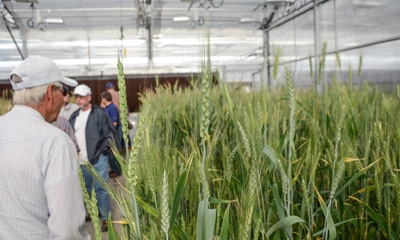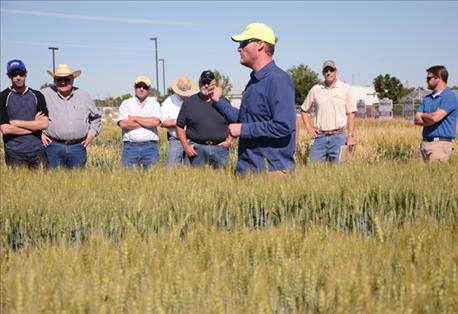
Just over a year ago, Monsanto reopened the doors to its updated Wheat Technology Center in Filer, Idaho. The new center follows a pattern in expanding wheat breeding programs around the globe, including other new wheat breeding facilities on the Plains and in the Pacific Northwest.

OPTIMAL LOCATION: Visitors gather in the greenhouse at Monsanto's Wheat Technology Center in Filer, Idaho. Nick Ihde, field testing and operations site lead at the center, notes the facility is in a prime spot for developing wheat seed. "It's relatively disease-free, and there's a good growing environment for seed production as well," Ihde explains. "We have adequate sunlight, a good water supply, a limited chance of severe weather like they have in the Plains. We have a little wind, but we don't have tornadoes or hail."
The center, situated on the Snake River Plain of southern Idaho, is in a prime spot for developing wheat seed, says Nick Ihde, field testing and operations site lead at the center. "It's relatively disease-free, and there's a good growing environment for seed production as well," Ihde explains. "We have adequate sunlight, a good water supply, a limited chance of severe weather like they have in the Plains. We have a little wind, but we don't have tornadoes or hail."
Located in Idaho, the center has ideal growing conditions for all major marketing classes of wheat — hard and soft, red and white. With the centralization of breeders comes optimization of field trials in plots throughout major wheat-growing regions of the U.S., where teams maintain field plots and take region-specific data on Monsanto varieties back to breeders.
"Enhanced precision and data collection in our yield trials across all regions is a major goal, and our state-of-the-art equipment makes this possible across all regions," Ihde says. "Additional in-the-cab instruments are being deployed in our combines to gather additional data and better enhance our understanding of how our varieties perform."
Advances in wheat breeding

ADVANCES IN WHEAT BREEDING: Mark Newell, spring wheat breeder at Monsanto, addresses the tour group at the facility's wheat plots. Newell notes the facility hopes to adopt genome-wide selection to select for traits like yield, test weight, protein and standability. "It allows us to select potential products based on yield before we ever actually evaluate them in the field," he says.
A major focus of the center is breeding for higher yields and making wheat a more profitable crop, says Mark Newell, spring wheat breeder at Monsanto. That's especially important in places like Nebraska, where wheat acres have dwindled in recent years. "In the past, the focus was on breeding for resistance to disease. On the farm, there are all sorts of ways to manage disease, but yield isn't always there," Newell says. "Wheat has been increasing 1% in yield each year due to genetics; but in other crops like corn and soybeans, it's been 2.5%."
Doubled haploid methods are often used cut the time it takes to create a homozygous plant and release a variety to the marketplace faster, when compared to traditional inbreeding systems. Newell notes there are some new genomic tools in the wheat breeder's toolbox to help deliver products to the marketplace faster, and help in the push for higher yields.
Phenotypic selection is the common method for trait selection across the wheat sector. In the near future, the facility hopes to use genome-wide selection to select for key traits like yield, test weight, protein and standability — the four most important traits for wheat growers. Such traits as tolerance to specific diseases are also being identified and introgressed at the genome-wide level.
"The bigger traits — yield, test weight, protein — we have some genetic components to select for, but a lot of it is field testing. Down the road, our goal is to move more toward genome-wide selection. Other crops are doing that and we're not quite there, but we're looking at it," Newell says. "It allows us to select potential products based on yield before we ever actually evaluate them in the field. It allows us to increase the size of our pipeline at a small cost, compared to running a yield trial for that potential product."
Genome-wide selection is already being used to push yields in other crops, like corn and soybeans. With the new facility, and with Monsanto's new across crop approach, Newell says wheat breeders have access to some tools they didn't in the past.
"There are a lot of tools for all crops at Monsanto, and now with an across-crop approach, we're seeing a lot of those tools and people working in wheat," Newell says. "We're trying to think about the whole system rather than just the individual crop. I think that's part of the march forward."
Localized recommendations
One step on the road to higher yields is characterizing specific varieties — knowing how many seeds per acre should be planted in a given field. With the new facility, Ihde explains seed counters fill testing packets with greater precision for each trial.
"We know exactly what population we're putting down, and we can also do planting density trials on seed population to determine how those varieties perform when seeded a little under or over," Ihde says. "Can they handle the stress and challenges of a very dense population, or do they not hold up under those conditions? What can we push? We have all these recommendations for corn and soybeans, but we probably don't know as much as we'd like to know for wheat."
This is where tools like WestBred's ConnectIn Wheat Insight System, released earlier this year, come in to identify optimum planting populations for specific varieties.
Trenton Stanger, wheat technical product manager for the Montana and Northwest regions at WestBred, says the next step is working with cooperating growers to conduct on-farm research trials across wheat-growing regions, not only to better characterize wheat varieties, but also to identify places where certain varieties are best-suited. "We're hoping to look at field-scale trials across multiple environments, multiple soil types — and really see how that variety performs in the region," Stanger says. "It's not only a benefit for me collecting more data, but for growers to see what works best for their farm."
About the Author(s)
You May Also Like






